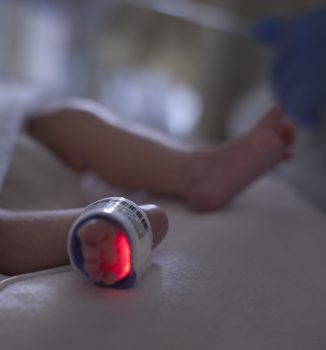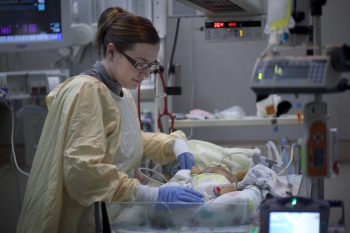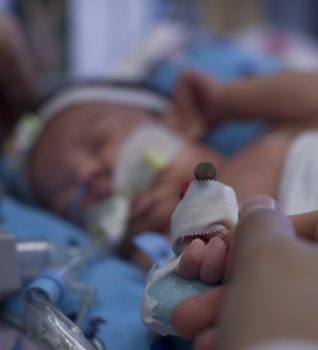
A newborn boy was admitted to Seattle Children’s Neonatal Intensive Care Unit (NICU) earlier this year with arthrogryposis — a condition where an infant cannot move, their joints becoming frozen in place. When geneticist Dr. Jimmy Bennett met the infant, he was on a respirator and could only move his eyes.
“We didn’t know the cause of the arthrogryposis and could not tell the parents much about their son’s prognosis — whether he would ever come off the ventilator or if he would be intellectually disabled,” Bennett said. “With so little information, it was difficult to decide how to proceed.”
This family had a previous pregnancy that was similarly affected. Bennett believed the cause might be genetic and recommended rapid exome sequencing (rES) — a blood test that can quickly detect genetic abnormalities.
Less than a week later, the test identified a specific condition that led providers to administer an appropriate therapy. Before long, the child was moving.
“Never in a million years would we have tried this therapy without the genetic test results,” Bennett said. “Two weeks later, the patient was off the ventilator and moving all four limbs. It was like a miracle.”
Unraveling mysterious diseases

To improve care of children with genetic conditions, Bennett is leading a quality improvement study at Seattle Children’s called the RIGhT (Rapid Inpatient Genomic Testing) Project. The goal is to obtain rapid genetic diagnoses for critically ill children who have been selected by a committee of geneticists.
The project, a collaboration with Bennett’s lab at Seattle Children’s Research Institute’s Center for Developmental Biology and Regenerative Medicine, will compare outcomes in patients who receive the testing to those who don’t.
“We are trying to develop evidence that rES is changing the care of critically ill children in our ICUs and should become the standard of care,” he said.
Since the development of clinically available rES, which only takes 7 to 10 days to return results, Bennett said there has been a realization among providers, particularly neonatologists, that genetic testing can benefit critically ill patients.
Impacting patient care

Since the RIGhT Project began in October 2017, rES has been ordered for approximately 30 ICU patients, mostly in the NICU.
In some cases, this genetic test identified the exact cause of an illness and an effective therapy was administered faster than it would have been without a diagnosis.
One child had calcifications — accumulations of calcium in tissue that can harden and disrupt the body’s normal processes — in blood vessels all over his body. Providers did not know whether the boy’s condition would be manageable or lethal.
Genetic testing identified the disease could be treated with a medication called bisphosphonates.
“Rapid sequencing allowed us to quickly reach a diagnosis, without delaying therapy,” Bennett said.
In other cases, rES has helped families and providers clarify the goals of care. Having more information about a child’s prognosis makes it easier to decide what treatments are appropriate.
In one such case, a boy was born with abnormally short limbs.
“It looked like a skeletal dysplasia,” Bennett said. “Some skeletal dysplasias are lethal or associated with really significant developmental issues, so it’s hard to predict what the future holds for these infants.”
rES revealed this child’s skeletal problems were not lethal and their cognitive function was expected to be typical.
“It gave everyone a lot of reassurance and helped the family determine it was in their best interest to do everything they could for their son,” Bennett said.
The RIGhT Project also addresses concerns about recurrence in future children. Parent samples are collected along with the patient’s to aid the lab in interpreting the results. This helps providers counsel parents on how likely it is that their future children will have the same condition.
“That’s really helpful, particularly when a family has a child with a chronic medical condition,” Bennett said. “Parents have to consider whether or not their family can emotionally and financially sustain another seriously ill child.”
The value of an explanation
 Some of the children participating in the RIGhT project have severe, even lethal, genetic diseases. Not all of them survive. But even when they don’t, Bennett said the information gained from genetic testing can benefit families.
Some of the children participating in the RIGhT project have severe, even lethal, genetic diseases. Not all of them survive. But even when they don’t, Bennett said the information gained from genetic testing can benefit families.
“A genetic diagnosis can offer clarity to a family and make it easier for them to focus on the quality — rather than the quantity — of time they have left with their child,” he said.
This was true for the family of the patient with arthrogryposis. While the boy was able to gain mobility, his prognosis was still very poor. The family chose to proceed with palliative care.
“It is always tragic when a child dies, but this family was still very grateful we ordered the test,” Bennett said. “We were able to treat the child so he could move and we gave the family a month with their son that they probably wouldn’t otherwise have had.”
With their previous pregnancy, the family had no explanation for their child’s abnormalities. Now, they have a clear understanding of why this happened.
“Parents want to know why their child has these differences; that’s the most important thing for a lot of them. Just knowing why offers tremendous emotional, spiritual and psychological value to families,” he said.
Creating a sustainable model
rES is not currently the standard of care, in part because the test is still relatively new and expensive — costing the lab approximately $10,000 per test.
It can be difficult to convince insurance companies to pay for this kind of test, but Bennett is hoping to change that.
“At Seattle Children’s, we always do what’s best for the patient, no matter the cost. But we want this to be sustainable, so we’re collecting data to demonstrate that this is providing the best care and might even save money by avoiding unnecessary tests and procedures,” he said.
The logistics of getting this test done in a timely manner are uniquely challenging. The possible outcomes of the test must be discussed with the parents ahead of time, and blood samples are needed from both parents — something that is unique to this test.
“It takes a coordinated, whole team effort to get this done, and I’m proud of the model we have developed for this project,” Bennett said. “It’s not just the genetics providers, it’s the neonatologists, genetic counselors, our administrative staff, nurses and laboratory staff who make this possible.”
Bennett hopes Seattle Children’s will be able to offer rES to more patients in the future.
“I believe genetic diagnosis is the first step to understanding how to take better care of a family and developing new treatments. There are children in our hospital who have conditions we cannot explain, and we owe it to families to figure out why,” he said.

